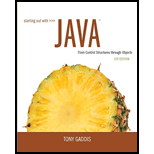
Concept explainers
Conversion
Write a program that asks the user to enter a distance in meters. The program will then present the following menu of selections:
- 1. Convert to kilometers
- 2. Convert to inches
- 3. Convert to feet
- 4. Quit the program
The program will convert the distance to kilometers, inches, or feet, depending on the user’s selection. Here are the specific requirements:
- • Write a void method named showKi1ometers, which accepts the number of meters as an argument. The method should display the argument converted to kilometers. Convert the meters to kilometers using the following formula:kilometers = meters * 0.001
- Write a void method named showlnches, which accepts the number of meters as an argument. The method should display the argument converted to inches. Convert the meters to inches using the following formula:inches = meters * 39.37
- Write a void method named showFeet, which accepts the number of meters as an argument. The method should display the argument converted to feet. Convert the meters to feet using the following formula:feet = meters * 3.281
- Write a void method named menu that displays the menu of selections. This method should not accept any arguments.
- The program should continue to display the menu until the user enters 4 to quit the program.
- The program should not accept negative numbers for the distance in meters.
- If the user selects an invalid choice from the menu, the program should display an error message.
Here is an example session with the program, using console input. The user’s input is shown in bold.
Enter a distance in meters: 500 [Enter]
- 1. Convert to kilometers
- 2. Convert to inches
- 3. Convert to feet
- 4. Quit the program
Enter your choice: 1 [Enter]
500 meters is 0.5 kilometers.
- 1. Convert to kilometers
- 2. Convert to inches
- 3. Convert to feet
- 4. Quit the program
Enter your choice: 3 [Enter]
500 meters is 1640.5 feet.
- 1. Convert to kilometers
- 2. Convert to inches
- 3. Convert to feet
- 4. Quit the program
Enter your choice: 4 [Enter]
Bye!
Learn your wayIncludes step-by-step video

Chapter 5 Solutions
Starting Out with Java: From Control Structures through Objects (6th Edition)
Additional Engineering Textbook Solutions
Starting Out with Python (4th Edition)
Mechanics of Materials (10th Edition)
Problem Solving with C++ (10th Edition)
SURVEY OF OPERATING SYSTEMS
Degarmo's Materials And Processes In Manufacturing
Starting Out with Java: From Control Structures through Data Structures (4th Edition) (What's New in Computer Science)
- 2:21 m Ο 21% AlmaNet WE ARE HIRING Experienced Freshers Salesforce Platform Developer APPLY NOW SEND YOUR CV: Email: hr.almanet@gmail.com Contact: +91 6264643660 Visit: www.almanet.in Locations: India, USA, UK, Vietnam (Remote & Hybrid Options Available)arrow_forwardProvide a detailed explanation of the architecture on the diagramarrow_forwardhello please explain the architecture in the diagram below. thanks youarrow_forward
- Complete the JavaScript function addPixels () to calculate the sum of pixelAmount and the given element's cssProperty value, and return the new "px" value. Ex: If helloElem's width is 150px, then calling addPixels (hello Elem, "width", 50) should return 150px + 50px = "200px". SHOW EXPECTED HTML JavaScript 1 function addPixels (element, cssProperty, pixelAmount) { 2 3 /* Your solution goes here *1 4 } 5 6 const helloElem = document.querySelector("# helloMessage"); 7 const newVal = addPixels (helloElem, "width", 50); 8 helloElem.style.setProperty("width", newVal); [arrow_forwardSolve in MATLABarrow_forwardHello please look at the attached picture. I need an detailed explanation of the architecturearrow_forward
- Information Security Risk and Vulnerability Assessment 1- Which TCP/IP protocol is used to convert the IP address to the Mac address? Explain 2-What popular switch feature allows you to create communication boundaries between systems connected to the switch3- what types of vulnerability directly related to the programmer of the software?4- Who ensures the entity implements appropriate security controls to protect an asset? Please do not use AI and add refrencearrow_forwardFind the voltage V0 across the 4K resistor using the mesh method or nodal analysis. Note: I have already simulated it and the value it should give is -1.714Varrow_forwardResolver por superposicionarrow_forward
- Describe three (3) Multiplexing techniques common for fiber optic linksarrow_forwardCould you help me to know features of the following concepts: - commercial CA - memory integrity - WMI filterarrow_forwardBriefly describe the issues involved in using ATM technology in Local Area Networksarrow_forward
 EBK JAVA PROGRAMMINGComputer ScienceISBN:9781305480537Author:FARRELLPublisher:CENGAGE LEARNING - CONSIGNMENTProgramming Logic & Design ComprehensiveComputer ScienceISBN:9781337669405Author:FARRELLPublisher:Cengage
EBK JAVA PROGRAMMINGComputer ScienceISBN:9781305480537Author:FARRELLPublisher:CENGAGE LEARNING - CONSIGNMENTProgramming Logic & Design ComprehensiveComputer ScienceISBN:9781337669405Author:FARRELLPublisher:Cengage EBK JAVA PROGRAMMINGComputer ScienceISBN:9781337671385Author:FARRELLPublisher:CENGAGE LEARNING - CONSIGNMENT
EBK JAVA PROGRAMMINGComputer ScienceISBN:9781337671385Author:FARRELLPublisher:CENGAGE LEARNING - CONSIGNMENT C++ Programming: From Problem Analysis to Program...Computer ScienceISBN:9781337102087Author:D. S. MalikPublisher:Cengage Learning
C++ Programming: From Problem Analysis to Program...Computer ScienceISBN:9781337102087Author:D. S. MalikPublisher:Cengage Learning Programming with Microsoft Visual Basic 2017Computer ScienceISBN:9781337102124Author:Diane ZakPublisher:Cengage Learning
Programming with Microsoft Visual Basic 2017Computer ScienceISBN:9781337102124Author:Diane ZakPublisher:Cengage Learning Microsoft Visual C#Computer ScienceISBN:9781337102100Author:Joyce, Farrell.Publisher:Cengage Learning,
Microsoft Visual C#Computer ScienceISBN:9781337102100Author:Joyce, Farrell.Publisher:Cengage Learning,





